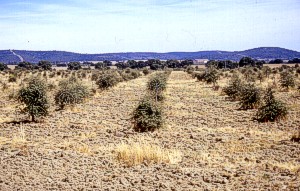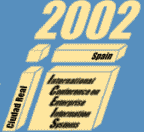|
| CIUDAD REAL |
 |
How
to get there
Ciudad Real is in Castilla - La Mancha, the Don
Quixote's land. It is not easy to categorize Castilla - La Mancha, for
it is a region of great variety and complexity. On the one ahnd,
ther is the ruddy red earth, the windmills, and simple whitewashed
villages of the province of Ciudad Real (which encompasses most jof the
area commonly called La Mancha).
But there also the strangely sculped cliffs of
Cuenca and Albacete, the hilly woodlands of Guadalajara and the dark
mystery and ancient cultures of Toledo. Ciudad Real is one hour by car
from Toledo, fifty minutes by train from Madrid, seventy minutes by train
from Córdoba and two hours by train from Sevilla.
HISTORY. PROVINCE OF CIUDAD REAL
Abundant traces of remote prehistoric times have
survived in this province, amongst which the schematic paintings of the
neolithic in the area of the Sierra Morena are of great interest, those at
Fuencaliente being particularly outstanding; the hillock of Azuer
(Daimiel), from the Bronze Age; the village of Bienvenida (in the Valley
of Alcudia) or the recently discovered Cerro de las Cabezas, in
Valdepeñas, which was already occupied in the 6th B.C.
An ancient city, founded in 1255,
which still preserves vestiges of its past. A frontier zone between
Christianity and the Arab civilisation. The great priory of San Juan, the
Order de Calatrava and the Knights of Saint James (Caballeros
Santiaguistas) gradually acquired sufficient strength to threaten the
authority of royal power. Alfonso X the Wise (El Sabio), in order to
counteract the growing power of the Orders, had Villa Real built and
surrounded it with walls with 120 towers. The expulsion of the Jews in 15C
and the incorporation of the territories of the military orders by the
Crown triggered off the decline of its Villas and the rise of the Royal
ones. In 1691, the province of La Mancha was created, along with the
remaining 21 provinces of Castilla, and Ciudad Real was its capital. From
1833 onwards, after the division of the peninsula into 49 provinces,
Ciudad Real became definitively the capital of the province which bears
its name.
NOT TO BE MISSED
Art
Among the main architectural constructions which the city offers to the
visitor, the following are particularly worthy of note: The Puerta
de Toledo, which is Mudéjar style. The arch at the entrance to
the Alcazar Real, built in what was the last part of the jewish quarter.
The church of San Pedro is the oldest church in Ciudad Real, it is
Romanesque in form. The Iglesia de Santiago is a beautiful 14 and 15C
Gothic building. The Cathedral of Nuestra Señora del Prado has just one
very large nave, outstanding is its marvellous Renaissance-style reredos.
The Jewish Quarter (Judería) was one of the biggest in Spain, at the
present time the only remains are in the Ciudad Real Provincial Museum
(Museo Provincial), which contains among its most important remains, the
door of a Jewish synagogue. Also worthy of note are remains from the
Paleolithic, late Bronze and Iron Ages. In the fine arts section, several
valuable works by Gregorio Prieto, Ubeda and Antonio López García are
outstanding. There is also a section devoted to new plastic styles.

Puerta de Toledo
Campos de Calatrava y Valdepeñas
Via the local road which crosses the Jabalón, you reach Aldea del Rey and
there you take the C410. In Calzada de Calatrava must is to make the trip to
the important ruins of Calatrava la Nueva, opposite which is the historic
castle of Salvatierra. You return to the C410 and continue as far as Viso del
Marqués, where you will find the National Archives of the Spanish Navy
(Archivo Nacional de la Marina Española). You go on to Santa Cruz de Mudela,
passing through the Santuario de las Virtudes. where its magnificent reredos
and ceiling can be seen, as well as its pretty non-detached, squareshaped
bullring. If you continue through the wine-producing lands of Valdepeñas you
will finally reach Almagro, head of the Order and Campo de Calatrava, where
you can admire its beautiful balconied square and theatre, where every year
the International Classical Theatre Festival takes place. The traveller will
no doubt be astonished by the delicate lace bobbin work. Almagro has been
declared an Area of Historical and Artistic interest. La Solana is a town near
Almagro which has a beautiful Manchegan square and the 15C Parish church of
San Sebastián.
Los Ojos del Guadiana
Travelling along these plains brings to mind the evocation of Cervantes' world
of Don Quixote and Sancho. But first let us begin with the surprise of the
lagoons called the eyes (ojos) of Guadiana. The Tablas de Daimiel,
whence the birds emigrate after their migration. It is a national park of
undoubted ecological value. From Daimiel you go towards Villarrubia de los
Ojos, and from there to Puerto Lápice with its beautiful Manchegan
fortifications, its inns and windmills. From this small town you will go to
Campo de Criptana, which for many, is the most beautiful village in La Mancha.
It is a village which spreads its white dwellings on the slope of a hill
topped by windmills. From Campo de Criptana to Alcázar de San Juan, another
landscape highlighted by its windmills. It also has an archaeological museum
with important Roman mosaics and the tower of Don Juan de Austria. In Pedro Muñoz
we can see lagoons of great ecological interest. Tomelloso, one of the wine
centres of La Mancha, has a surrounding countryside in which there is an
abundance of the typical buildings of this region called "bombos".
You can see the Cart (Carro) Museums and that of the artist Antonio López and
the inn (Posada) de los Portales, which is in the main square (Plaza Mayor).
San Carlos del Valle has a typical 18C square.

Tablas de Daimiel
Sierra Morena
This route has the aim of making, direct contact with nature. For this
purpose, you take the N420 to Almodóvar del Campo, a town which has a
beautiful parish church, with a splendid Mudéjar ceiling. You continue
towards the Niefla pass, from where you have panoramic views of the Campo de
Calatrava and the Valle de Alcudia. It may be of interest to pay a visit to
Fuencaliente, with its spa and the caves of Peña Escrita and la Batanera
which have prehistoric diagram paintings.
Campo de Montiel
This is a region which historically was part of the Order of Santiago. You
begin the itinerary from Valdepeñas and make a leisurely stop in the splendid
town of Villanueva de los Infantes, a majestic town in the Montiel countryside
which originated in the Augustan antiquarian colony; there Francisco de
Quevedo died. It has an outstanding main square, surrounded by neo Classical
pillars. Afterwards you head for the lagoons (lagunas) de Ruidera.
This is surprising and beautiful scenery, stretching for thirty kilometres,
with a succession of lagoons linked by waterfalls, and a Mediterranean
tree-lined scenery. It is more than an oasis in La Mancha, there you can
practise all kinds of aquatic sporting activities such as sailing, windsurfing
and fishing.

Lagunas de Ruidera
Montes de Toledo
Leaving Ciudad Real by the N401, you come to Fernancaballero, the gateway to
the Gasset reservoir. This trip offers us three options for venturing further
into the Montes de Toledo, the first will take you to Navas de Estena, after
going round the Torre de Abraham lake. The second option leads you as far as
Horcajo de los Montes, with a view of mountain ranges and plains making up an
outstanding natural landscape with its own flora and fauna. You can also see
the Cabañeros National Park. The third possibility takes you to Puebla de Don
Rodrigo, on the outskirts of which the Guadiana, at this point full of water,
can be seen.

Montes de Toledo
Links with information
about Spain
TURESPAÑA:
http://www.tourspain.es
University of Castilla - La
Mancha: http://www.uclm.es/
Train information:
http://www.renfe.es/ingles/index.html
Ciudad Real region location in Spain:
http://tuspain.com/travel/regbc.htm
The Land of Dom
Quijote: http://www.elquijote.org/
Page Updated on
19-10-2006
Copyright © Escola Superior de Tecnologia
de Setúbal, Instituto Politécnico de Setúbal |






